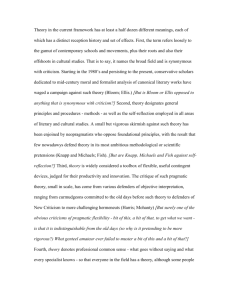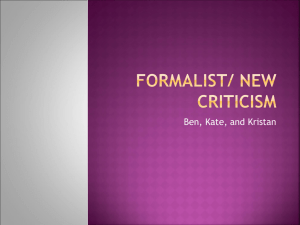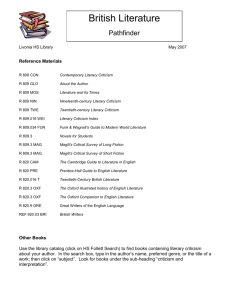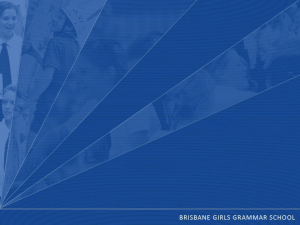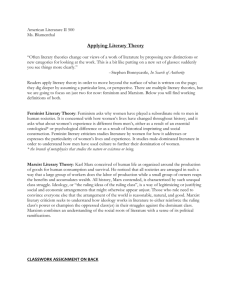Literary Criticism
advertisement
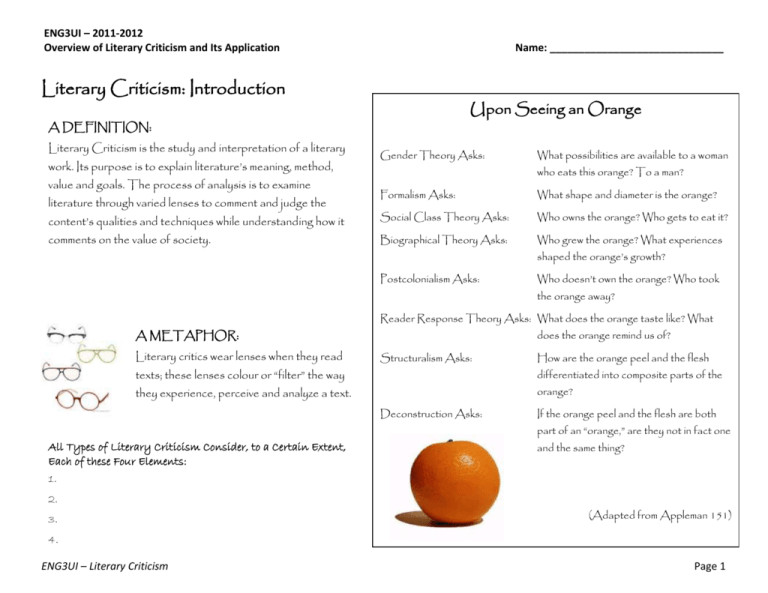
ENG3UI – 2011-2012 Overview of Literary Criticism and Its Application Name: ______________________________ Literary Criticism: Introduction Upon Seeing an Orange A DEFINITION: Literary Criticism is the study and interpretation of a literary work. Its purpose is to explain literature’s meaning, method, value and goals. The process of analysis is to examine Gender Theory Asks: What possibilities are available to a woman who eats this orange? To a man? Formalism Asks: What shape and diameter is the orange? content’s qualities and techniques while understanding how it Social Class Theory Asks: Who owns the orange? Who gets to eat it? comments on the value of society. Biographical Theory Asks: Who grew the orange? What experiences literature through varied lenses to comment and judge the shaped the orange’s growth? Postcolonialism Asks: Who doesn’t own the orange? Who took the orange away? Reader Response Theory Asks: What does the orange taste like? What A METAPHOR: Literary critics wear lenses when they read does the orange remind us of? Structuralism Asks: How are the orange peel and the flesh texts; these lenses colour or “filter” the way differentiated into composite parts of the they experience, perceive and analyze a text. orange? Deconstruction Asks: If the orange peel and the flesh are both part of an “orange,” are they not in fact one All Types of Literary Criticism Consider, to a Certain Extent, Each of these Four Elements: 1. and the same thing? 2. 3. (Adapted from Appleman 151) 4. ENG3UI – Literary Criticism Page 1 ENG3UI – 2011-2012 Overview of Literary Criticism and Its Application Name: ______________________________ Gender/Feminist Criticism "Feminism is, at its core, very simple: the belief that men and women should have equal opportunity for self-expression" (Foss 151). The Theory: Examines how female characters are portrayed in literature Exposes the patriarchal ideology embedded in “classic” literature Sees the exclusion of women from the literary canon as a political as well as an aesthetic act Demonstrates that attitudes and traditions reinforcing systematic masculine dominance are inscribed in “classic” literature Rejects the idea of “essential” feminine attributes Examines the experience of women from all races, classes and cultures Argues that differences of race, class and culture give rise to crucial differences among women through history and from varied geographical areas Questions for the Gender/Feminist Lens: 1. How are women’s lives portrayed in the work? 2. Is the form and content of the work influenced by the author’s gender? 3. How do male and female characters relate to one another? Are these relationships sources of conflict? Are these conflicts resolved? 4. Does the work challenge or affirm traditional views of women? 5. How do the images of women in the story reflect patriarchal social forces that have impeded women’s efforts to achieve full of equality with men? 6. What behavioural expectations are imposed on the characters? What effect do these expectations have? 7. If a female character were male, how would the story be different? (and vice versa?) 8. How does the marital status of a character affect her decisions or happiness? Contends that gender is seen as a construct, not tied strictly to biology Assumes that the work does not have an objective status, an autonomy; instead, any reading of it is influenced by the reader’s own Notes: status, which includes gender, or attitudes toward gender. Suggests that men and women have not had equal access in the production of literature and within stories themselves. Maintains that men and women are different: they write differently, read differently, and write about their reading differently. These differences should be valued. ENG3UI – Literary Criticism Page 2 ENG3UI – 2011-2012 Overview of Literary Criticism and Its Application Name: ______________________________ A Feminist Reading: “Lamb to the Slaughter” and “Boys and Girls” Use your understanding of literary criticism based on gender to analyze these two stories with a “feminist” lens. Analysis of a Character in the Story Quotation(s) that Illustrate(s) a Gender /Feminist Reading Themes that Emerge about Gender Literary Devices that Aid in Gender/Feminist Reading (e.g., symbols, imagery, tone, analogy…) “Boys and Girls” “Lamb to the Slaughter” Story ENG3UI – Literary Criticism Page 3 ENG3UI – 2011-2012 Overview of Literary Criticism and Its Application Name: ______________________________ Social Class/Marxist Criticism “The history of all hitherto existing society is the history of class struggles.” – Karl Marx The Theory: struggles.” – Karl Marx Is based upon the political and economic theories of Karl Marx and Frederick Engels (19 century philosophers) th Explore the way different groups of people are represented in texts. Evaluates the level of social realism in the text and how society is portrayed. Focuses on the dominant and the repressed classes (Bourgeoisie vs. Proletariat) (Rich vs. Poor) (Powerful vs. Weak) Looks at the effects of power and money drawn from economic or social class. Has the main objective of finding how the text reveals the ideological oppression of a dominant class Considers how the text itself is a commodity that reproduces certain social beliefs and practices. Analyze the social effect Questions for the Social Class/Marxist Lens: 1. What is the relationship between the characters and their society? 2. Does the story address societal issues, such as race, gender, and class? 3. How do social forces shape the power relationships between groups or classes of people in the story? Who has the power, and who does not? Why? 4. How does the story reflect the Great American Dream? 5. How does the story reflect urban, rural, or suburban values? 6. What does the work say about economic or social power? Who has it and who does not? Any Marxist leanings evident? 7. Does the story address issues of economic exploitation? What role does money play? 8. How do economic conditions determine the direction of the characters’ lives? 9. Does the work challenge or affirm the social order it depicts? 10. Can the protagonist’s struggle be seen as symbolic of a larger class struggle? How does the microcosm of the story reflect the macrocosm of the society in which it was composed? 11. Do any of the characters correspond to types of government, such as a dictatorship, democracy, socialism, etc.? What attitudes toward these political structures/systems are expressed in the work? of the literary work. Argues these ideas of Karl Marx: i. That the way people think and behave in any society is Notes: determined by basic economic factors; ii. Those groups of people who owned and controlled major industries could exploit the rest of the population, through conditions of employment and by forcing their own values and beliefs onto other social groups. ENG3UI – Literary Criticism Page 4 ENG3UI – 2011-2012 Overview of Literary Criticism and Its Application Name: ______________________________ A Social Class/Marxist Reading: “Boys and Girls” and “Harrison Bergeron” Use your understanding of literary criticism based on social class to analyze these two stories with a “Marxist” lens. Analysis of a Character in the Story Quotation(s) that Illustrate(s) a Social Class/Marxist Reading Themes that Emerge about Social Class Literary Devices that Aid in Social Class/Marxist Reading (e.g., symbols, imagery, tone, analogy…) “Harrison Bergeron” “Boys and Girls” Story ENG3UI – Literary Criticism Page 5

